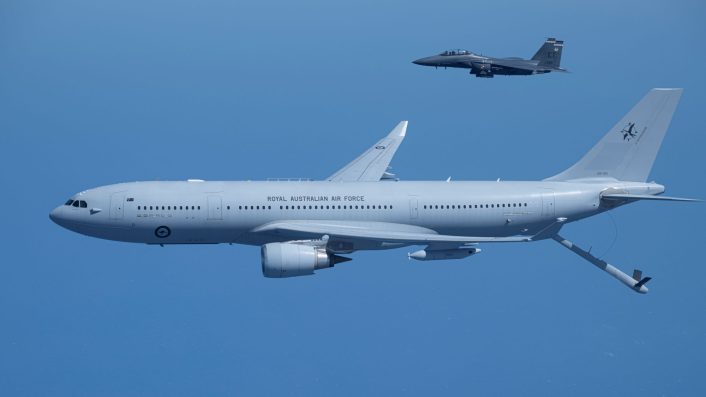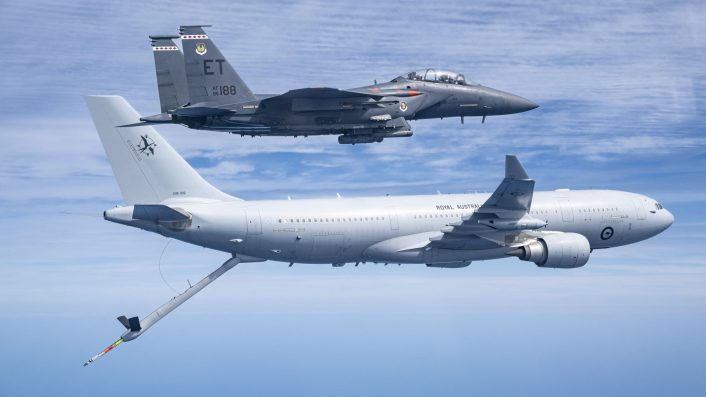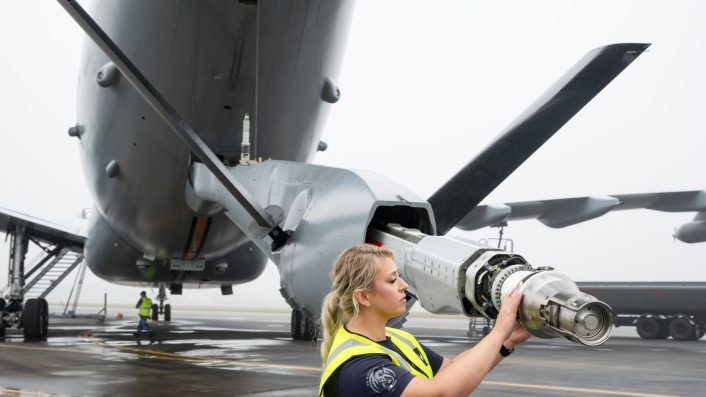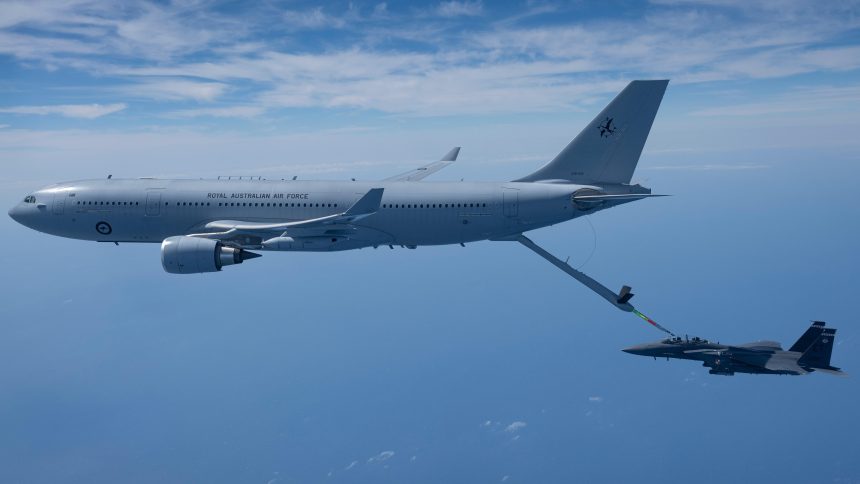Together with the RAAF E-7A Wedgetail refueled by an USAF KC-46A Pegasus, the RAAF KC-30 being able to refuel F-15s enhances interoperability between Australia and the U.S.
The RAAF (Royal Australian Air Force) has cleared its KC-30A MRTT aerial tanker to refuel the U.S. Air Force’s F-15EX Eagle II and F-15E Strike Eagle fighters at the end of a testing campaign in March 2025 at Eglin AFB, Florida, the service revealed last week. The KC-30A is the Australian designation for the Airbus A330 MRTT (Multi-Role Tanker Transport).
This shed some light on the trilateral U.S., British and Australian effort early in April to certify the KC-46A Pegasus to refuel the E-7A Wedgetail AEW&C (Airborne Early Warning and Control) aircraft at Edwards AFB, California. The Aviationist reported this later that month, following a release from the 412th Test Wing, noting the E-7A/KC-46A testing helped generate data, verify compatibility and firm up procedures, before the E-7 becomes operational with the USAF and the RAF (Royal Air Force).
Both the trials saw “hundreds of refueling contacts” between the Australian and American aircraft, increasing interoperability between the two militaries by expanding the list of aircraft cleared for air-to-air refueling, the RAAF release added. The RAAF’s ARDU (Aircraft Research and Development Unit) from RAAF Base Williamtown and the USAF’s 40th Flight Test Squadron (40th FLTS) from Eglin AFB were involved in the trials.
RAAF KC-30A refuels USAF F-15EX Eagle II
As the RAAF said the “two trials occurred over March and April,” it could be assumed that the flights to certify the RAAF KC-30A with the USAF F-15s took place in March, since, as mentioned above, the tests of the RAAF E-7A Wedgetail with the USAF KC-46A were held in April. While at Eglin AFB, “a RAAF KC-30A multi-role tanker transport aircraft refueled, for the first time, a USAF F-15EX Eagle II, and continued refueling testing for the F-15E Strike Eagle variant,” the RAAF statement said.
In the same framing, the release then mentioned the KC-46A and E-7A trials, specifying that those were the first such activities too, noting that “between the two trials, hundreds of refueling contacts were made.” The RAAF’s images, however, show only the F-15E Strike Eagle from the 40th FLTS making contact and flying with the RAAF’s KC-30A, with the boom just above the Eagle’s AAR receptacle, on its port-side engine intake.

The F-15EX Eagle II is not captured in the flight tests, but is seen in an ground image under an aircraft sunshade, as RAAF and USAF personnel interact around the aircraft. The aircraft appears to be airframe 20-0001, which was the first jet rolled out and assigned to the 40th FLTS at Eglin AFB.
Testing campaign
The RAAF press release quoted Sqn. Ldr. Alex Barbaro, a flight test engineer, and the new RAAF Base Williamtown Flight Commander from ARDU, who served as the Flight Test Lead for the KC-30A and Strike Eagle/Eagle II trial. The joint team trialed various flight conditions to determine the safest type of refueling operations. This involved fixing boom release, fuel transfer and boom recovery practices suited to each aircraft’s flight characteristics, as the new aircraft fly only a risky few meters behind the other.
The April RAAF E-7A Wedgetail and the USAF KC-46A Pegasus trials were described as the first time “in about ten years” that air-to-air boom receiver testing was conducted with an Australian aircraft. The last time was in 2015, when the E-7A was certified with the KC-30A, as per Sqn. Ldr. Owen Hamilton.

Hamilton, the outgoing ARDU chief, added that the testing “leveraged results from previous air-to-air test campaigns,” with the E-7A being flown “to the very limit of its performance, and to the extremities of the KC-46 boom limits.” This was to identify inadvertent “extreme positions” the operators might find themselves in.
The large amounts of data collected by the ARDU and the 40th FLTS from the tests at Eglin and Edwards will be analyzed and provided to the respective Systems Program Offices and the US Aerial Refueling Certification Agency. “The expansion of air-to-air refueling clearances directly enhances Australia’s interoperability with United States and allied partners and, by virtue, increases our ability to deliver air power,” added Hamilton.
Military and strategic significance
The testing campaign comes as the U.S. Air Force’s PACAF (Pacific Air Forces) aims to qualitatively enhance its presence in the Indo-Pacific, deploying the advanced F-15EX and more F-35A Lightning II jets. The new capability enhances U.S.’s options for the coming high-end war with an increasingly capable China in the Indo-Pacific.
As part of the plan, the service is retiring its older 24 South Korea-based A-10s by fiscal year 2025, assigned to the 51st Fighter Wing (51st FW) within the 7th Air Force, which oversees Korea and the Northwest Pacific. The unit is also receiving F-16 Fighting Falcons upgraded through the Post Block Integration Team (PoBIT), transferred from Misawa’s 35th Fighter Wing (35th FW).
Additionally, on Jul. 12, 2025, two F-15EX Eagle IIs, from the 85th Test and Evaluation Squadron at Eglin AFB, arrived at Kadena Air Base, Japan, accompanied by an F-15E Strike Eagle and an F-16C Fighting Falcon of the same unit. This was to help Kadena AB, which hosts the 44th and 67th Fighter Squadrons under the 18th Wing, to prepare for the arrival and future sustainment of the F-15EX.

As part of a Jul. 3, 2025 DoD modernization plan, the 18th Wing will replace the retired 48 Eagles with 36 new F-15EX Eagle IIs. Misawa will also receive 48 F-35As, starting in 2026, to replace its F-16s.
American, Australian, Japanese and South Korean navies have recently exercised together in the region. The new refueling testing now eases the employment of JASDF’s (Japan Air Self-Defense Force) F-15J and RoKAF’s (Republic of Korea Air Force) F-15K Slam Eagles together with RAAF KC-30As, in addition to U.S. aircraft.
The RAAF operates seven KC-30As assigned to the No. 33 Squadron at RAAF Base Amberley. The KC-30A MRTT carries an Advanced Refueling Boom on the centerline and two underwing hose-and-drogue systems.
The RAAF’s F/A-18F Super Hornet and E/A-18G Growler use the KC-30A’s hose-and-drogue to refuel. On the other hand, F-35A Lightning II, E-7A Wedgetail, C-17A Globemaster III, P-8A Poseidon, other KC-30As and non-Australian U.S/Allied F-16C, B-2 Spirit and B-1B Lancer are compatible with the boom.

For instance, RAAF KC-30A was certified to refuel JASDF Mitsubishi F-2s in an Apr. 2022 testing campaign, with nine test flights at Komaki Air Base. Both the single-seat F-2A and twin-seat F-2B aircraft refueled from the Australian KC-30A boom in a variety of payload and lighting conditions.









